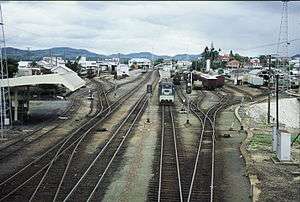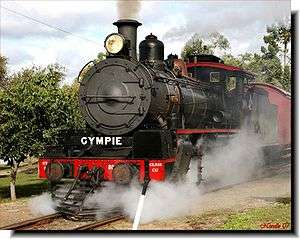Gympie railway station
 Southbound view of Gympie yard in 1987 | |
| Location | Tozer Street, Gympie |
| Coordinates | 26°11′15″S 152°40′16″E / 26.1874°S 152.6712°ECoordinates: 26°11′15″S 152°40′16″E / 26.1874°S 152.6712°E |
| Owned by | Queensland Rail |
| Operated by | Mary Valley Heritage Railway |
| Line(s) |
North Coast (past) Mary Valley Heritage Railway (present) |
| Platforms | 2 (1 island) |
| Construction | |
| Structure type | Ground |
| History | |
| Opened | 6 August 1881 |
| Closed | 1995 |
Gympie railway station is an Australian heritage-listed former railway station in Gympie, Queensland on the North Coast line. It was the primary railway station serving Gympie from 1881 until 1989.
Original railway station



After the discovery of gold in October 1867 by James Nash in Gympie, the requirement of a railway line linked to a port became apparent. In 1877, the Queensland Government approved the construction of three railways to connect mining towns to their principal ports: Townsville to Charters Towers; Bundaberg to Mount Perry; and Maryborough to Gympie. The station buildings at Gympie and Maryborough were positioned at the terminus of the track line, marking the railway’s dead end status. The line opened on 6 August 1881.[1]
Within a year of the line opening, Gympie representatives began lobbying for a rail link to Brisbane and on 17 July 1891, the Gympie to Brisbane line was opened.[1] This is when the original building was re-sited from the end of the track to the southern side of the line, allowing the line to pass through Gympie.[2]
1913 station
The passing of the North Coast Railway Act in 1910 which linked the separate regional divisions of Queensland Railways into one network, provided increased spending and construction works within Queensland railways. Construction commenced on the present station in 1913, which commenced operations on 1 December 1913.[2] The station was based on the Queensland Railways A ‘Pagoda’ standard design.[2] Positioned on an island platform the long narrow chamfer-board building housed: a bar; refreshment room and servery; waiting room; ladies room; station master’s office; telegraph and booking office; and a sheltered sales area. The smaller upper floor housed: the kitchen; scullery; and pantry. This floor was serviced by a hand operated lift.
Major works
Other major works to improve the facilities include
- A subway and luggage lift to provide access from the southern end of the island platform to the station entrance.
- An adjacent underpass to replace the gated crossing between Station Road and Mellor Street.
- A large timber two-span overbridge with steps leading from the island platform and steps leading onto Lady Mary Terrace and Station Road.
Closure
After 1906, gold production declined and by 1925 the last of the big mines had ceased operations. Agriculture and dairying had begun to emerge as key industries within the Gympie district and in 1915 the Mary Valley branch railway was opened. These industries heavily relied on rail transport. Fruit trains began operating from Gympie to Melbourne from 1923, and in 1929 the Gympie Fruit Growers Co-operative Association erected their premises opposite the station on Tozer Street.
By the 1930s, the Gympie Railway Station Complex had evolved into one of Queensland’s most substantial and busy railway complexes. In 1963 a new ticket and parcel office was built within the former parking area adjoining the subway entrance (where the Gympie Family History Society is now located). For over a century the station complex was intrinsically linked to the economy of Gympie and surrounding areas and played an important role in Queensland’s rail network however by the end of the 1980s it had become mostly redundant.
As part of the electrification of the North Coast line between Brisbane and Rockhampton, an eight kilometre eastern deviation bypassed the station, with a new Gympie North station opening on 4 February 1989.[3] Gympie was relegated to a freight depot, closing In 1995.[4] On 9 November 1998, the line from Gympie North station to Gympie station was closed at a point 300 metres north of the station.[5]
Valley Rattler
The Mary Valley Heritage Railway became the custodians of much of the Gympie Railway Station Complex through a lease from the Queensland Railways for 50 years and on 23 May 1998 the Valley Rattler began operations on the former Mary Valley branch line after negotiations for the lease was extended to the line to Imbil[6] and became a major tourist attraction of the region.
Unfortunately after two very serious derailments during August and September 2012, the limitations and state of the railway company's finances became known. It was shut down indefinitely by Transport & Main Roads, as it was declared unsafe to convey passengers. Following flood damage in 2013, the railway disbanded.[7] In June 2016, the Gympie Regional Council allocated $250,000 for operational start-up costs and $3.8 million for capital funds to restart the Rattler.[8]
Heritage listing
The station was listed on the Queensland Heritage Register on 14 October 2011.[2][9]
References
- 1 2 "A city of romance". The Cairns Post. Qld: National Library of Australia. 19 November 1917. p. 3. Retrieved 26 May 2012.
- 1 2 3 4 "Gympie Railway Station Platform Complex (entry 602036)". Queensland Heritage Register. Queensland Heritage Council. Retrieved 13 July 2015.
- ↑ Hansard Queensland Parliament 27 February 1986
- ↑ Life on the Railway - Real Stories Gympie Rail History
- ↑ "QR Withdraws from Gympie" Railway Digest January 1999 age 12
- ↑ "Keeping a tradition alive". Gympie Times. 14 February 2012.
- ↑ Atkinson, Bruce (17 July 2015). "Hope remains for historic Mary Valley Rattler steam train funding". Australian Broadcasting Corporation. Retrieved 18 June 2016.
- ↑ "Rattler to get $4m kiss of life and ratepayers a 2.1% rise". Gympie Times. 15 June 2016. Retrieved 18 June 2016.
- ↑ "Gympie's three heritage 'hits'". The Gympie Times. 22 October 2011.
External links
![]() Media related to Gympie railway station at Wikimedia Commons
Media related to Gympie railway station at Wikimedia Commons
- Gympie station Queensland's Railways on the Internet